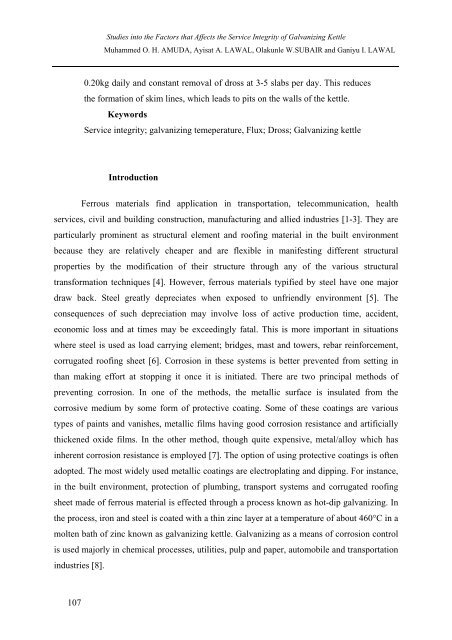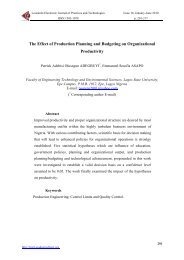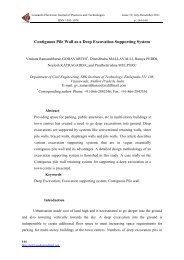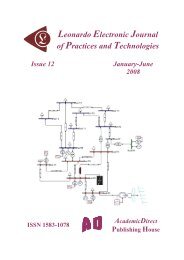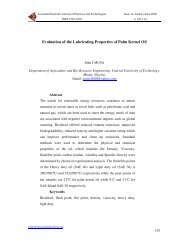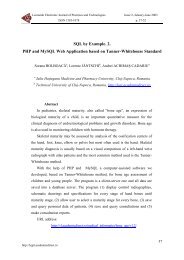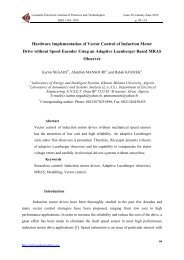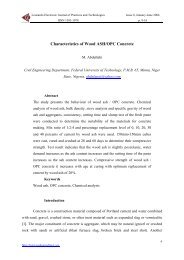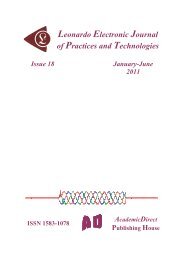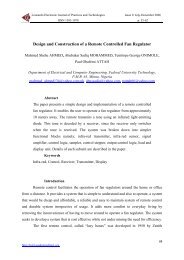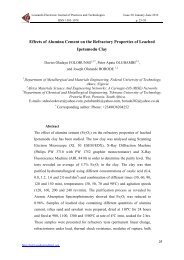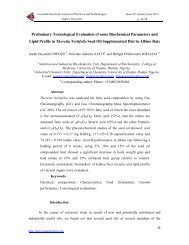p. 106-121 - Leonardo Electronic Journal of Practices and ...
p. 106-121 - Leonardo Electronic Journal of Practices and ...
p. 106-121 - Leonardo Electronic Journal of Practices and ...
You also want an ePaper? Increase the reach of your titles
YUMPU automatically turns print PDFs into web optimized ePapers that Google loves.
107<br />
Studies into the Factors that Affects the Service Integrity <strong>of</strong> Galvanizing Kettle<br />
Muhammed O. H. AMUDA, Ayisat A. LAWAL, Olakunle W.SUBAIR <strong>and</strong> Ganiyu I. LAWAL<br />
0.20kg daily <strong>and</strong> constant removal <strong>of</strong> dross at 3-5 slabs per day. This reduces<br />
the formation <strong>of</strong> skim lines, which leads to pits on the walls <strong>of</strong> the kettle.<br />
Keywords<br />
Service integrity; galvanizing temeperature, Flux; Dross; Galvanizing kettle<br />
Introduction<br />
Ferrous materials find application in transportation, telecommunication, health<br />
services, civil <strong>and</strong> building construction, manufacturing <strong>and</strong> allied industries [1-3]. They are<br />
particularly prominent as structural element <strong>and</strong> ro<strong>of</strong>ing material in the built environment<br />
because they are relatively cheaper <strong>and</strong> are flexible in manifesting different structural<br />
properties by the modification <strong>of</strong> their structure through any <strong>of</strong> the various structural<br />
transformation techniques [4]. However, ferrous materials typified by steel have one major<br />
draw back. Steel greatly depreciates when exposed to unfriendly environment [5]. The<br />
consequences <strong>of</strong> such depreciation may involve loss <strong>of</strong> active production time, accident,<br />
economic loss <strong>and</strong> at times may be exceedingly fatal. This is more important in situations<br />
where steel is used as load carrying element; bridges, mast <strong>and</strong> towers, rebar reinforcement,<br />
corrugated ro<strong>of</strong>ing sheet [6]. Corrosion in these systems is better prevented from setting in<br />
than making effort at stopping it once it is initiated. There are two principal methods <strong>of</strong><br />
preventing corrosion. In one <strong>of</strong> the methods, the metallic surface is insulated from the<br />
corrosive medium by some form <strong>of</strong> protective coating. Some <strong>of</strong> these coatings are various<br />
types <strong>of</strong> paints <strong>and</strong> vanishes, metallic films having good corrosion resistance <strong>and</strong> artificially<br />
thickened oxide films. In the other method, though quite expensive, metal/alloy which has<br />
inherent corrosion resistance is employed [7]. The option <strong>of</strong> using protective coatings is <strong>of</strong>ten<br />
adopted. The most widely used metallic coatings are electroplating <strong>and</strong> dipping. For instance,<br />
in the built environment, protection <strong>of</strong> plumbing, transport systems <strong>and</strong> corrugated ro<strong>of</strong>ing<br />
sheet made <strong>of</strong> ferrous material is effected through a process known as hot-dip galvanizing. In<br />
the process, iron <strong>and</strong> steel is coated with a thin zinc layer at a temperature <strong>of</strong> about 460°C in a<br />
molten bath <strong>of</strong> zinc known as galvanizing kettle. Galvanizing as a means <strong>of</strong> corrosion control<br />
is used majorly in chemical processes, utilities, pulp <strong>and</strong> paper, automobile <strong>and</strong> transportation<br />
industries [8].


